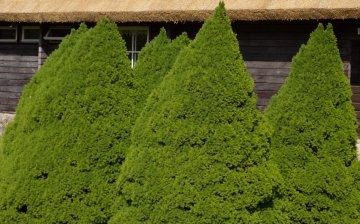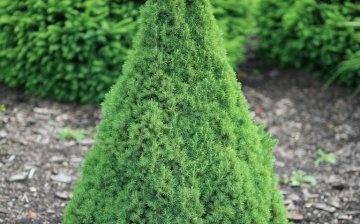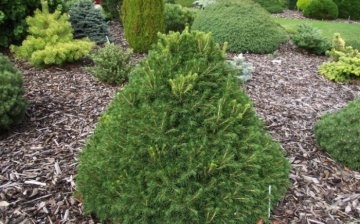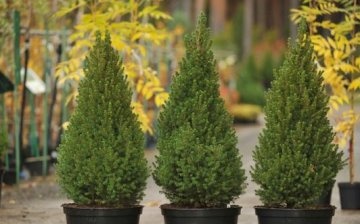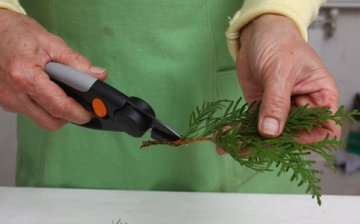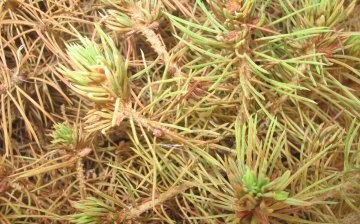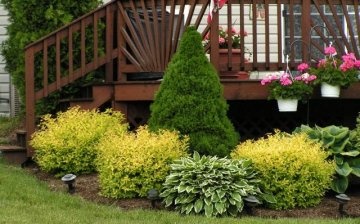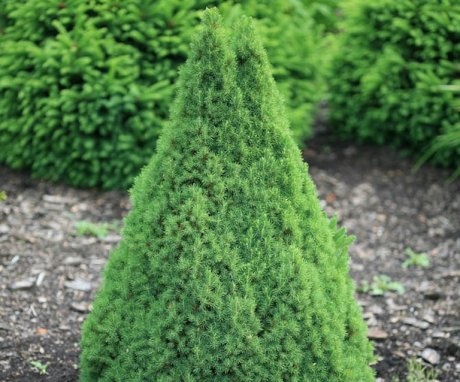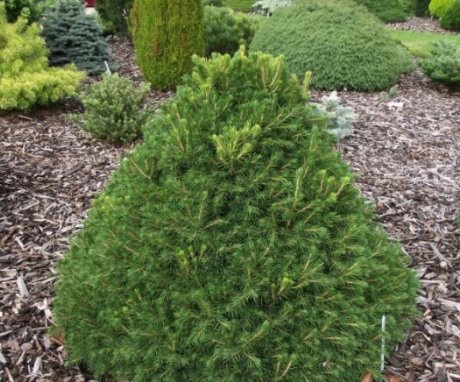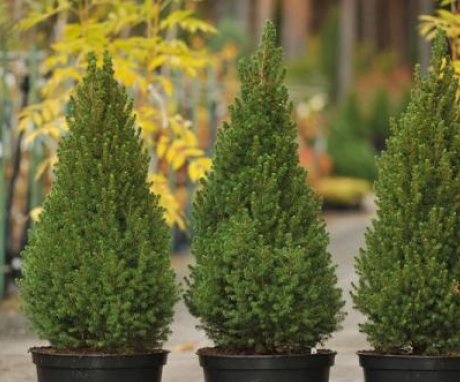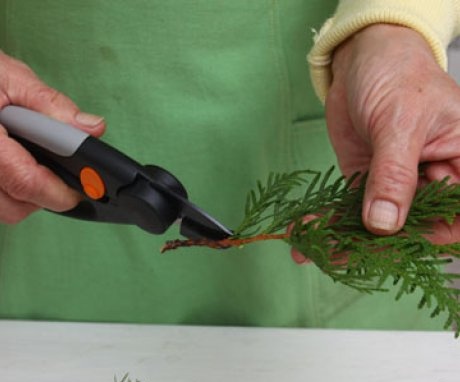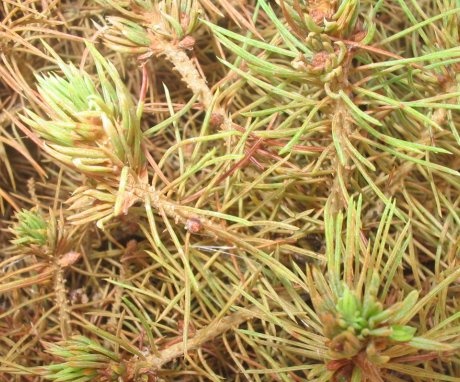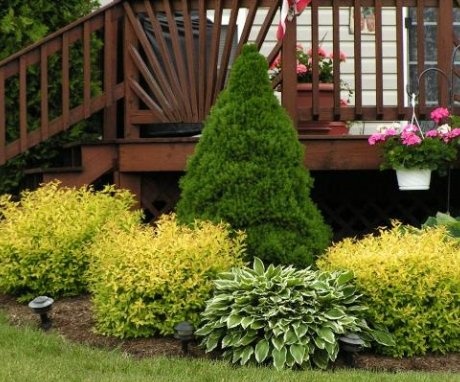Canadian conic: varieties and features of growing decorative spruce
Among landscape designers, dwarf and decorative ate... These trees fit perfectly into the composition, look great and, thanks to their coniferous nature, they plant greenery on the site all year round. The Canadian conic is a prominent representative of the decorative spruce, with unusual short needles and a fluffy, regular-shaped crown.
Content:
- General information and varieties
- Care
- Planting seedlings
- Reproduction
- Diseases and pests
- Application
General information and varieties
Canadian conic is a perennial plant that grows in the form of a tree and belongs to the conifers family. Breeders have bred many dwarf varieties that are actively used by landscape designers to create decorative plantings. Dwarf spruces grow slowly, so they can often be found in offices and homes, especially on New Year's holidays.
Basically, all varieties are frost-resistant and unpretentious to care for.
Popular varieties:
- Spruce canadian conic. The height of the Canadian conic generally does not exceed 2-2.5 meters, but some specimens, upon reaching 35-40 years of age, can stretch by 3.5 meters. The Canadian conic has a short, up to 0.6 mm and soft needles of a pleasant green-gray color. The crown in width reaches 2 meters in diameter. The peculiarity of this tree is that it grows slowly. This is a great advantage when planting in decorative perennial compositions. The growth of the Canadian conic increases by a maximum of 10 cm per year, and this is with proper care and favorable growing conditions. The crown has a regular conical shape, without exposing the lower part of the trunk. Resistant to frost.
- Spruce Canadian Sanders Blue. It is very popular among landscape designers for the beautiful color of the needles and the correct conical shape. The plant reaches its maximum growth only at the age of 30. The trunk extends 3 meters in height. The spruce grows slowly, by the age of 10 it barely exceeds 80 cm. The branches are dense, dense. The soft needles are colored in a bluish-green tone. Frost-resistant and unpretentious in leaving.
Care
For planting Canadian spruce, it is recommended to select a place closed from drafts, well lit with light shading. The soil should be fertile and loamy. It is undesirable for groundwater to pass through the place where the tree grows. It is also good to plant spruce in the plain, in high places it can be too windy and dry, and depressions and lowlands usually collect a large amount of water, which also negatively affects the plant.
Canadian conic needs regular wateringespecially during hot summer days and dry periods.
The soil under the plant must be constantly moist so that the surface roots do not dry out. But excessive watering can lead to waterlogging of the ground. It also negatively affects root system ate. On hot days, it is recommended to water the plant through the crown, that is, spray it completely from the hoses.
After watering, after 1-2 days, it is necessary to loosen the soil to allow enough oxygen to pass to the root system. In parallel with this, all weeds... The process must be carried out carefully so as not to damage the root system.
Top dressing:
- Canadian conic needs an annual spring feeding... During this period, special complex fertilizers for coniferous plants or poured rotted compost, which is mixed in equal parts with peat.
- It is worth remembering that the root system of the spruce is practically on the surface, so the soil cannot be tamped.
Konik is a frost-resistant plant, therefore it does not need shelter for the winter period. But it is recommended to protect the needles from the spring sun. During the period when the sun becomes bright and warm enough, and the snow has not melted yet, the reflected rays can cause great harm to the plant. It is recommended to cover the crown with burlap or cardboard shields so that the air can easily circulate around the spruce, and the material does not come into contact with the needles too tightly. The crown of the conic has a regular conical shape by nature. The need for pruning no.
Planting seedlings
Only those trees that are 4-5 years old are planted in the ground. Until then, it is recommended to keep the plants in special pots. This period is maintained in order for the spruce root system, which is mainly on the surface, to get stronger. But for a longer period, Canadian conic should not grow in pots indoors, as this can lead to the death of the plant.
Planting in open ground is recommended in cool or cloudy weather, so that the sun does not dry out the soil and roots.
If the seedling was purchased with closed roots, then for this process you can choose the early spring month, when the snow has just melted. If the spruce has a bare root system, then for planting it is necessary to wait until the weather is stable, not hot, and the soil warms up enough.
Front landing it is necessary to prepare the soil. For this, organic or mineral complex fertilizers for coniferous crops. The soil is well watered to make it easier for the root system to adapt. After planting, the plant must be shaded from direct sunlight for several days. This will protect the needles from wilting and rapid evaporation of moisture.
Reproduction
Canadian conic reproduces using cuttings and seed... Process cuttings spend in the spring:
- Young, healthy branches are selected and separated from the trunk together with its piece, the so-called heel.
- The process of cuttings is carried out in cloudy weather.
- Trees are selected with a middle age of 5 to 10 years, branches must be cut from the middle of the crown.
- One stalk should be approximately 7-11 cm long. It is detached with a sharp downward movement so that a little wood and bark of the mother plant remains on it.
- After preparing the material, all cuttings are kept in a stimulating solution for 20-25 hours.
- Cuttings are immersed in pre-prepared loose, fertile and light soil to a depth of 2-3 cm. It is recommended to plant them at an angle of 30 degrees to the ground.
- A container with seedlings is placed in greenhouse... After a while, young shoots should appear, after which the rooting process begins. It lasts up to about 6 months. In some cases, the root system appears only the next year.
- The plantings need to be looked after regularly. Air and water, sometimes adding stimulating ingredients to the water.
- The soil should not completely dry out in the container, but it is also not recommended to allow waterlogging.
For propagation using seeds, the source material can be purchased at a special store or by collecting well-opened ripe cones in the winter. Seeds must be prepared for planting by treating them with disinfectant and stimulating solutions. After that, they are sown shallowly in a special container with loose and fertile soil.
Diseases and pests
One of pestsThe bark beetle, which can greatly harm the Canadian bunny, is the bark beetle.Only prophylactic properties can be used against it. If an insect starts in a tree, such a plant cannot be saved. It is urgent to remove it from the site and burn it so that the pests do not move to neighboring plantations.
Also, sometimes coniferous trees are affected by the hedgehog false shield. This can be seen by the yellowing and falling needles. If this pest is found, then the infected plants and all neighboring plants must process 3% BI-58 solution.
With improper care, excessive watering and high humidity, fungal diseases attack conifers.
Some of them can be healed. Rust will be visible by the unsightly orange growths on the trunk and branches. To remove it, it is necessary to treat the infected plant with special chemicals once a week for 1-2 months. drugs... But tracheomycosis cannot be cured. It can be seen by the reddened needles, which fall off after a while. Such trees are urgently removed from the site and burned.
Application
Dwarf conifers are used as decorative plantings in gardens, parks and areas near private houses. When young, they are grown in pots and are often used to decorate offices and homes.
Landscape designers have been using these trees for years to create evergreen compositions and decorative plantings.
Using the simple skills of a gardener, you can grow a small green beauty on your own site. Simple rules leaving, and the unpretentiousness of the trees will allow you to enjoy the beauty of the plantings all year round. Interesting natural forms of dwarf firs make it possible to show imagination and create a unique decorative composition.
More information can be found in the video.



